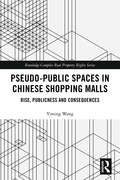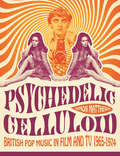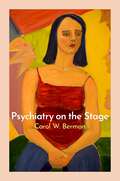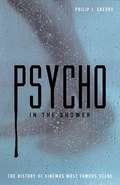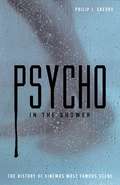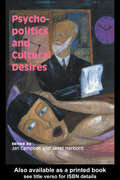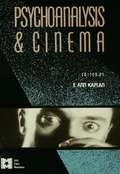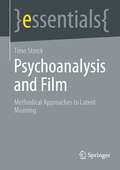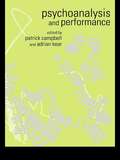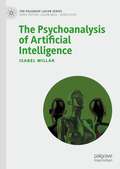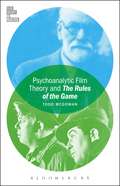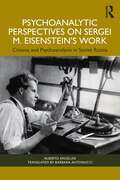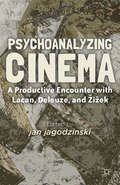- Table View
- List View
Pseudo-Public Spaces in Chinese Shopping Malls: Rise, Publicness and Consequences (Routledge Complex Real Property Rights Series)
by Yiming WangShopping malls in China create a new pseudo-public urban space which is under the control of private or quasi-public power structure. As they are open for public use, mediated by the co-mingling of private property rights and public meanings of urban space, the rise, publicness and consequences of the boom in the construction of shopping malls raises major questions in spatial political economy and magnifies existing theoretical debates between the natural and conventional schools of property rights. In examining these issues this book develops a theoretical framework starting with a critique of the socio-spatial debate between two influential bodies of work represented by the work of Henri Lefebvre and David Harvey. Drawing on the framework, the book examines why pseudo-public spaces have been growing so rapidly in China since the 1980s; assesses to what degree pseudo-public spaces are public, and how they affect the publicness of Chinese cities; and explores the consequences of their rise. Findings of this book provide insights that can help to better understand Chinese urbanism and also have the potential to inform urban policy in China. This book will be of interest to academics and researchers in both Chinese studies and urban studies.
Pseudo-Public Spaces in Chinese Shopping Malls: Rise, Publicness and Consequences (Routledge Complex Real Property Rights Series)
by Yiming WangShopping malls in China create a new pseudo-public urban space which is under the control of private or quasi-public power structure. As they are open for public use, mediated by the co-mingling of private property rights and public meanings of urban space, the rise, publicness and consequences of the boom in the construction of shopping malls raises major questions in spatial political economy and magnifies existing theoretical debates between the natural and conventional schools of property rights. In examining these issues this book develops a theoretical framework starting with a critique of the socio-spatial debate between two influential bodies of work represented by the work of Henri Lefebvre and David Harvey. Drawing on the framework, the book examines why pseudo-public spaces have been growing so rapidly in China since the 1980s; assesses to what degree pseudo-public spaces are public, and how they affect the publicness of Chinese cities; and explores the consequences of their rise. Findings of this book provide insights that can help to better understand Chinese urbanism and also have the potential to inform urban policy in China. This book will be of interest to academics and researchers in both Chinese studies and urban studies.
Psychedelic Celluloid: British Pop Music in Film & TV 1965 - 1974
by Simon MatthewsPsychedelic Celluloid is the definitive guide to the decade when swinging London was the film capital of the world. Illustrated throughout with colour images of the period and covering over 300 British and European films and TV shows, Psychedelic Celluloid moves from the Beatles via Bond spin offs to crazy personal folies des grandeurs, Blow Up and its imitators, concert movies, documentaries, stylish horror films and many more. Carefully researched and drawing on interviews with some of the survivors of the era, Psychedelic Celluloid provides a witty and detailed account of each major production, listing its stars, directors, producers and music and showing how they were linked to the fashion and trends of the period.'Psychedelic Celluloid covers the swinging sixties in minute detail, noting the influence of pop on hundreds of productions' - The Independent 'While the pop and rock of the 60s has been the subject of innumerable studies, and people have catalogued the films too, often at great length, up until now no one has put the two together' -Little White Lies 'A richly illustrated guide' - The BooksellerONLY SUITABLE FOR VIEWING ON A LAPTOP, COMPUTER or LARGE TABLET
Psychiatry on the Stage: How Plays Can Enhance Our Understanding of Psychiatric Conditions
by Carol W. BermanPsychology and theater have often intersected in the most interesting ways to describe characters, situations, and interactions. Neuroscience is in the process of discovering how the brain longs for patterns that we find in theater and other art forms, and practitioners in psychiatry frequently refer to literature and drama to better understand patients. For instance, the Oedipal complex was first illustrated in Sophocles' Oedipus Rex, and Sigmund Freud largely derived his understanding of psychiatric complexes from his familiarity with Greek mythology. Psychiatry on the Stage presents an overview of basic psychiatric principles applied to plays from the Greeks to modern times. Additional features include illustrative vignettes from the author's practice and several detailed indexes comprised of plays, corresponding playwrights, and various psychiatric and neurological disorders. As a board-certified psychiatrist and playwright, Dr. Berman is uniquely qualified to explore the connections between psychiatry and theater. This book is sure to appeal to both practitioners in the field of psychiatry and theater enthusiasts alike.
Psychiatry on the Stage: How Plays Can Enhance Our Understanding of Psychiatric Conditions
by Carol W. BermanPsychology and theater have often intersected in the most interesting ways to describe characters, situations, and interactions. Neuroscience is in the process of discovering how the brain longs for patterns that we find in theater and other art forms, and practitioners in psychiatry frequently refer to literature and drama to better understand patients. For instance, the Oedipal complex was first illustrated in Sophocles' Oedipus Rex, and Sigmund Freud largely derived his understanding of psychiatric complexes from his familiarity with Greek mythology. Psychiatry on the Stage presents an overview of basic psychiatric principles applied to plays from the Greeks to modern times. Additional features include illustrative vignettes from the author's practice and several detailed indexes comprised of plays, corresponding playwrights, and various psychiatric and neurological disorders. As a board-certified psychiatrist and playwright, Dr. Berman is uniquely qualified to explore the connections between psychiatry and theater. This book is sure to appeal to both practitioners in the field of psychiatry and theater enthusiasts alike.
Psycho in the Shower: The History of Cinema's Most Famous Scene
by Philip J. Skerry"With this book, Philip Skerry makes an ambitious and largely successful effort to restore perspective to the debate that has swirled around Psycho since Hitchcock first ripped back the shower curtain of our expectations in 1960 and plunged his knife into the collective cinematic consciousness." - John Baxter, Film International Psycho in the Shower is a multi-dimensional study of Psycho's astonishing shower scene. Philip J. Skerry shows how it may be the most significant and influential film scene of all and substantiates this claim by providing chapters on the evolution of the scene in Hitchcock's career, with particular focus on his methods for creating suspense and terror in the audience. In tracing the evolution of the shower scene, the author discusses and analyzes many films (both Hitchcockian and otherwise) that lead up to Psycho. The book places the shower scene in the cultural and social contexts of American popular culture of the 1950s and 1960s, arguing that it helped to create a revolution in both sensibility and cinematic style. Several unique dimensions help to set this study apart from other books on Psycho and Hitchcock: extensive and detailed interviews with people who worked on the film, including star Janet Leigh and screenwriter Joseph Stefano (the last significant interviews before their deaths); a close study of Hitchcock's employment of mise en scene and montage in the scenes leading up to the famous shower murder; a shot by shot analysis of the scene itself and a discussion of the numerous controversies surrounding it; and a provocative and insightful account of the writing of the book itself, which provides a unique look at the author's creative process. The book culminates with examples of how the shower scene has become embedded in the matrix of contemporary culture and the remarkable ways in which the scene affected people on first viewing.
Psycho in the Shower: The History of Cinema's Most Famous Scene (Studies In History And Criticism Of Film #Vol. 11)
by Philip J. Skerry"With this book, Philip Skerry makes an ambitious and largely successful effort to restore perspective to the debate that has swirled around Psycho since Hitchcock first ripped back the shower curtain of our expectations in 1960 and plunged his knife into the collective cinematic consciousness." - John Baxter, Film International Psycho in the Shower is a multi-dimensional study of Psycho's astonishing shower scene. Philip J. Skerry shows how it may be the most significant and influential film scene of all and substantiates this claim by providing chapters on the evolution of the scene in Hitchcock's career, with particular focus on his methods for creating suspense and terror in the audience. In tracing the evolution of the shower scene, the author discusses and analyzes many films (both Hitchcockian and otherwise) that lead up to Psycho. The book places the shower scene in the cultural and social contexts of American popular culture of the 1950s and 1960s, arguing that it helped to create a revolution in both sensibility and cinematic style. Several unique dimensions help to set this study apart from other books on Psycho and Hitchcock: extensive and detailed interviews with people who worked on the film, including star Janet Leigh and screenwriter Joseph Stefano (the last significant interviews before their deaths); a close study of Hitchcock's employment of mise en scene and montage in the scenes leading up to the famous shower murder; a shot by shot analysis of the scene itself and a discussion of the numerous controversies surrounding it; and a provocative and insightful account of the writing of the book itself, which provides a unique look at the author's creative process. The book culminates with examples of how the shower scene has become embedded in the matrix of contemporary culture and the remarkable ways in which the scene affected people on first viewing.
Psycho-Politics And Cultural Desires
by Jan Harbord Jan CampbellA cultural studies textbook that deals with issues of methodology, as well as mapping out the history and theories and ideas in cultural studies. The book examines the work of Raymond Williams, Lacan and Hoggart, among Others, And Explores Notions Of Subculture, Psychoanalysis, Marxist thought, narrative, autobiography, fiction, subjectivity, language, history and representation. The book focuses on the past, present and future of cultural studies, with the aim of providing readers with a clear overview of the central ideas within the area, developing current debates and possible future avenues.
Psycho-Politics And Cultural Desires
by Janet Harbord Jan CampbellA cultural studies textbook that deals with issues of methodology, as well as mapping out the history and theories and ideas in cultural studies. The book examines the work of Raymond Williams, Lacan and Hoggart, among Others, And Explores Notions Of Subculture, Psychoanalysis, Marxist thought, narrative, autobiography, fiction, subjectivity, language, history and representation. The book focuses on the past, present and future of cultural studies, with the aim of providing readers with a clear overview of the central ideas within the area, developing current debates and possible future avenues.
Psychoanalysis and Cinema (AFI Film Readers)
by E. Ann KaplanThese fifteen carefully chosen essays by well-known scholars demonstrate the vitality and variety of psychoanalytic film criticism, as well as the crucial role feminist theory has played in its development. Among the films discussed are Duel in the Sun, The Best Years of Our Lives, Three Faces of Eve, Tender is the Night, Pandora's Box, Secrets of the Soul, and the works of Jacques Tourneur (director of The Cat People and other features).
Psychoanalysis and Cinema (AFI Film Readers)
by E. Ann KaplanThese fifteen carefully chosen essays by well-known scholars demonstrate the vitality and variety of psychoanalytic film criticism, as well as the crucial role feminist theory has played in its development. Among the films discussed are Duel in the Sun, The Best Years of Our Lives, Three Faces of Eve, Tender is the Night, Pandora's Box, Secrets of the Soul, and the works of Jacques Tourneur (director of The Cat People and other features).
Psychoanalysis and Film: Methodical Approaches to Latent Meaning (essentials)
by Timo StorckThis essential is dedicated to the connection between psychoanalysis and film. Psychoanalysis is suitable for a methodically guided film viewing. This is not an application of psychoanalytical theory, but rather an application of its method of a reflected relationship to a counterpart. In this way, latent meanings can be taken into consideration and an interpretation can be developed. This essential reconstructs the possibilities of such an approach and presents existing approaches. Finally, a guideline for carrying out a film psychoanalytical interpretation is proposed. Numerous film examples serve to illustrate this.The translation was done with the help of artificial intelligence. A subsequent human revision was done primarily in terms of content.
Psychoanalysis and Performance
by Patrick Campbell Adrian KearThe field of literary studies has long recognised the centrality of psychoanalysis as a method for looking at texts in a new way. But rarely has the relationship between psychoanalysis and performance been mapped out, either in terms of analysing the nature of performance itself, or in terms of making sense of specific performance-related activities. In this volume some of the most distinguished thinkers in the field make this exciting new connection and offer original perspectives on a wide variety of topics, including: · hypnotism and hysteria · ventriloquism and the body · dance and sublimation · the unconscious and the rehearsal process · melancholia and the uncanny · cloning and theatrical mimesis · censorship and activist performance · theatre and social memory. The arguments advanced here are based on the dual principle that psychoanalysis can provide a productive framework for understanding the work of performance, and that performance itself can help to investigate the problematic of identity.
Psychoanalysis and Performance
by Patrick Campbell Adrian KearThe field of literary studies has long recognised the centrality of psychoanalysis as a method for looking at texts in a new way. But rarely has the relationship between psychoanalysis and performance been mapped out, either in terms of analysing the nature of performance itself, or in terms of making sense of specific performance-related activities. In this volume some of the most distinguished thinkers in the field make this exciting new connection and offer original perspectives on a wide variety of topics, including: · hypnotism and hysteria · ventriloquism and the body · dance and sublimation · the unconscious and the rehearsal process · melancholia and the uncanny · cloning and theatrical mimesis · censorship and activist performance · theatre and social memory. The arguments advanced here are based on the dual principle that psychoanalysis can provide a productive framework for understanding the work of performance, and that performance itself can help to investigate the problematic of identity.
Psychoanalysis and the Artistic Endeavor: Conversations with literary and visual artists (Psychoanalysis in a New Key Book Series)
by Lois OppenheimPsychoanalysis and the Artistic Endeavor offers an intriguing window onto the creative thinking of several well-known and highly creative individuals. Internationally renowned writers, painters, choreographers, and others converse with the author about their work and how it has been informed by their life experience. Creative process frames the discussions, but the topics explored are wide-ranging and the interrelation of the personal and professional development of these artists is what comes to the fore. The conversations are unique in providing insight not only into the art at hand and into the perspective of each artist on his or her own work, but into the mind from which the work springs. The interviews are lively in a way critical writing by its very nature is not, rendering the ideas all that much more accessible. The transcription of the live interview reveals the kind of reflection censored elsewhere, the interplay of personal experience and creative process that are far more self-consciously shaped in a text written for print. Neither private conversation nor public lecture, neither crafted response (as to the media) nor freely associative discourse (as in the analytic consulting room), these interviews have elements of all. The volume guides the reader toward a deeper psychologically oriented understanding of literary and visual art, and it engages the reader in the honest and often-provocative revelations of a number of fascinating artists who pay testimony to their work in a way no one else can. This is a unique collection of particular interest for psychoanalysts, scholars, and anyone looking for a deeper understanding of the creative process.
Psychoanalysis and the Artistic Endeavor: Conversations with literary and visual artists (Psychoanalysis in a New Key Book Series)
by Lois OppenheimPsychoanalysis and the Artistic Endeavor offers an intriguing window onto the creative thinking of several well-known and highly creative individuals. Internationally renowned writers, painters, choreographers, and others converse with the author about their work and how it has been informed by their life experience. Creative process frames the discussions, but the topics explored are wide-ranging and the interrelation of the personal and professional development of these artists is what comes to the fore. The conversations are unique in providing insight not only into the art at hand and into the perspective of each artist on his or her own work, but into the mind from which the work springs. The interviews are lively in a way critical writing by its very nature is not, rendering the ideas all that much more accessible. The transcription of the live interview reveals the kind of reflection censored elsewhere, the interplay of personal experience and creative process that are far more self-consciously shaped in a text written for print. Neither private conversation nor public lecture, neither crafted response (as to the media) nor freely associative discourse (as in the analytic consulting room), these interviews have elements of all. The volume guides the reader toward a deeper psychologically oriented understanding of literary and visual art, and it engages the reader in the honest and often-provocative revelations of a number of fascinating artists who pay testimony to their work in a way no one else can. This is a unique collection of particular interest for psychoanalysts, scholars, and anyone looking for a deeper understanding of the creative process.
Psychoanalysis and the Image: Transdisciplinary Perspectives (New Interventions in Art History)
by Griselda PollockPsychoanalysis and the Image brings together an influential team of international scholars who demonstrate innovative ways to apply psychoanalytical resources in the study of international modern art and visual representation. Examines psychoanalytic concepts, values, debates and controversies that have been hallmarks of visual representation in the modern and contemporary periods Covers topics including melancholia, sex, and pathology to the body, and parent-child relations Advances theoretical debates in art history while offering substantive analyses of significant bodies of twentieth century art Edited by internationally renowned art historian Griselda Pollock.
The Psychoanalysis of Artificial Intelligence (The Palgrave Lacan Series)
by Isabel MillarThis book examines the crucial role of psychoanalysis in understanding what AI means for us as speaking, sexed subjects. Drawing on Lacanian theory and recent clinical developments it explores what philosophy and critical theory of AI has hitherto neglected: enjoyment. Through the reconceptualization of Intelligence, the Artificial Object and the Sexual Abyss the book outlines the Sexbot as a figure who exists on the boundary of psychoanalysis and AI. Through this figure and the medium of film, the author subverts Kant’s three Enlightenment questions and guides readers to transition from asking 'Does it think?' to 'Can it enjoy?' The book will appeal in particular to students and scholars of psychoanalysis, philosophy, film and media studies, critical theory, feminist theory and AI research.
Psychoanalytic Film Theory and The Rules of the Game (Film Theory in Practice)
by Todd McGowanThe Film Theory in Practice Series fills a gaping hole in the world of film theory. By marrying the explanation of film theory with interpretation of a film, the volumes provide discrete examples of how film theory can serve as the basis for textual analysis. The first book in the series, Psychoanalytic Film Theory and The Rules of the Game, offers a concise introduction to psychoanalytic film theory in jargon-free language and shows how this theory can be deployed to interpret Jean Renoir's classic film. It traces the development of psychoanalytic film theory through its foundation in the thought of Sigmund Freud and Jacques Lacan through its contemporary manifestation in the work of theorists like Slavoj Žižek and Joan Copjec. This history will help students and scholars who are eager to learn more about this important area of film theory and bring the concepts of psychoanalytic film theory into practice through a detailed interpretation of the film.
Psychoanalytic Film Theory and The Rules of the Game (Film Theory in Practice)
by Todd McGowanThe Film Theory in Practice Series fills a gaping hole in the world of film theory. By marrying the explanation of film theory with interpretation of a film, the volumes provide discrete examples of how film theory can serve as the basis for textual analysis. The first book in the series, Psychoanalytic Film Theory and The Rules of the Game, offers a concise introduction to psychoanalytic film theory in jargon-free language and shows how this theory can be deployed to interpret Jean Renoir's classic film. It traces the development of psychoanalytic film theory through its foundation in the thought of Sigmund Freud and Jacques Lacan through its contemporary manifestation in the work of theorists like Slavoj Žižek and Joan Copjec. This history will help students and scholars who are eager to learn more about this important area of film theory and bring the concepts of psychoanalytic film theory into practice through a detailed interpretation of the film.
Psychoanalytic Perspectives on Sergei M. Eisenstein's Work: Cinema and Psychoanalysis in Soviet Russia
by Alberto AngeliniIn this insightful book, Alberto Angelini shows the influence of psychoanalysis and psychology on Sergei M. Eisenstein, one of the most celebrated Russian directors, and his cinematic output. Angelini situates Eisenstein’s life and oeuvre in the history and culture of twentieth-century Russia, drawing clear parallels between his networking with key figures such as Lev Vygotsky and Aleksandr Luria. He utilises the tools of psychology with the insight of psychoanalysis to illuminate the ways in which Eisenstein understood art as an anthropological enterprise while maintaining the same dialectical philosophy as the director in highlighting the many disciplines and figures that he drew inspiration from. Angelini also looks in depth at the influence psychoanalytic theories of regression had on Eisenstein’s approach to art, while examining the impact Stalinism had directly on both Eisenstein and psychoanalysis at large from the 1930s onwards. This book is an essential resource for psychoanalysts, students, and scholars of film studies, as well as those interested in the intersection between psychoanalytic theory, cinema, and the arts.
Psychoanalytic Perspectives on Sergei M. Eisenstein's Work: Cinema and Psychoanalysis in Soviet Russia
by Alberto AngeliniIn this insightful book, Alberto Angelini shows the influence of psychoanalysis and psychology on Sergei M. Eisenstein, one of the most celebrated Russian directors, and his cinematic output. Angelini situates Eisenstein’s life and oeuvre in the history and culture of twentieth-century Russia, drawing clear parallels between his networking with key figures such as Lev Vygotsky and Aleksandr Luria. He utilises the tools of psychology with the insight of psychoanalysis to illuminate the ways in which Eisenstein understood art as an anthropological enterprise while maintaining the same dialectical philosophy as the director in highlighting the many disciplines and figures that he drew inspiration from. Angelini also looks in depth at the influence psychoanalytic theories of regression had on Eisenstein’s approach to art, while examining the impact Stalinism had directly on both Eisenstein and psychoanalysis at large from the 1930s onwards. This book is an essential resource for psychoanalysts, students, and scholars of film studies, as well as those interested in the intersection between psychoanalytic theory, cinema, and the arts.
Psychoanalytic Studies of Creativity, Greed, and Fine Art: Making Contact with the Self
by David P LevineThroughout the history of psychoanalysis, the study of creativity and fine art has been a special concern. Psychoanalytic Studies of Creativity, Greed and Fine Art: Making Contact with the Self makes a distinct contribution to the psychoanalytic study of art by focusing attention on the relationship between creativity and greed. This book also focuses attention on factors in the personality that block creativity, and examines the matter of the self and its ability to be present and exist as the essential element in creativity. Using examples primarily from visual art David Levine explores the subjects of creativity, empathy, interpretation and thinking through a series of case studies of artists, including Robert Irwin, Ad Reinhardt, Susan Burnstine, and Mark Rothko. Psychoanalytic Studies of Creativity, Greed and Fine Art explores the highly ambivalent attitude of artists toward making their presence known, an ambivalence that is evident in their hostility toward interpretation as a way of knowing. This is discussed with special reference to Susan Sontag’s essay on the subject of interpretation. Psychoanalytic Studies of Creativity, Greed and Fine Art contributes to a long tradition of psychoanalytically influenced writing on creativity including the work of Deri, Kohut, Meltzer, Miller and Winnicott among others. It will be of interest to psychoanalysts, psychoanalytic psychotherapists, historians and theorists of art.
Psychoanalytic Studies of Creativity, Greed, and Fine Art: Making Contact with the Self
by David P LevineThroughout the history of psychoanalysis, the study of creativity and fine art has been a special concern. Psychoanalytic Studies of Creativity, Greed and Fine Art: Making Contact with the Self makes a distinct contribution to the psychoanalytic study of art by focusing attention on the relationship between creativity and greed. This book also focuses attention on factors in the personality that block creativity, and examines the matter of the self and its ability to be present and exist as the essential element in creativity. Using examples primarily from visual art David Levine explores the subjects of creativity, empathy, interpretation and thinking through a series of case studies of artists, including Robert Irwin, Ad Reinhardt, Susan Burnstine, and Mark Rothko. Psychoanalytic Studies of Creativity, Greed and Fine Art explores the highly ambivalent attitude of artists toward making their presence known, an ambivalence that is evident in their hostility toward interpretation as a way of knowing. This is discussed with special reference to Susan Sontag’s essay on the subject of interpretation. Psychoanalytic Studies of Creativity, Greed and Fine Art contributes to a long tradition of psychoanalytically influenced writing on creativity including the work of Deri, Kohut, Meltzer, Miller and Winnicott among others. It will be of interest to psychoanalysts, psychoanalytic psychotherapists, historians and theorists of art.
Psychoanalyzing Cinema: A Productive Encounter with Lacan, Deleuze, and Žižek
by Jan JagodzinskiThe essays within this collection explore the possibilities and potentialities of all three positions, presenting encounters that are, at times contradictory, at other times supportive, as well as complementary. The collection thereby enriches the questions that are being raised within contemporary cinematic studies.
